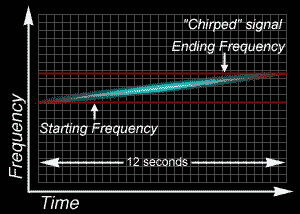SETI@home: Data Chirping
|
Needless to say, it's quite unlikely that an alien planet will be at rest with respect to Earth. You may remember that we (and our telescope in Arecibo) are whizzing along on a rotating planet which is revolving around the Sun, which in turn is orbiting the center of our Milky Way galaxy, etc. We can assume that our extra-terrestrial friends are likewise situated.
Radio waves emitted from a moving source and/or received by a moving target show a phenomenon called "the Doppler effect." For example, when you hear a car honking as it passes you, the frequency—or pitch—of the sound changes as the car passes.
|

©2025 University of California
SETI@home and Astropulse are funded by grants from the National Science Foundation, NASA, and donations from SETI@home volunteers. AstroPulse is funded in part by the NSF through grant AST-0307956.
 Although our remote friends aren't honking their horns at us, they are sending waves (electromagnetic waves) at us. Their signal will be distorted by the mutual motions of our two systems in much the same way that moving car horns are distorted. This "chirped" signal would appear to change in frequency over time, as shown by the figure to the right. To control for chirping, the SETI@home screensaver analyzes the data many times over trying a great variety of possible Doppler accelerations. First, the screensaver mathematically "undoes" a specific doppler acceleration or "chirp" from the data. It then feeds the resulting "de-accelerated" data to the
Although our remote friends aren't honking their horns at us, they are sending waves (electromagnetic waves) at us. Their signal will be distorted by the mutual motions of our two systems in much the same way that moving car horns are distorted. This "chirped" signal would appear to change in frequency over time, as shown by the figure to the right. To control for chirping, the SETI@home screensaver analyzes the data many times over trying a great variety of possible Doppler accelerations. First, the screensaver mathematically "undoes" a specific doppler acceleration or "chirp" from the data. It then feeds the resulting "de-accelerated" data to the